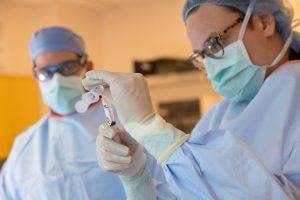Gina Kolata in The New York Times:
 When Georgia Bowen was born by emergency cesarean on May 18, she took a breath, threw her arms in the air, cried twice, and went into cardiac arrest. The baby had had a heart attack, most likely while she was still in the womb. Her heart was profoundly damaged; a large portion of the muscle was dead, or nearly so, leading to the cardiac arrest. Doctors kept her alive with a cumbersome machine that did the work of her heart and lungs. The physicians moved her from Massachusetts General Hospital, where she was born, to Boston Children’s Hospital and decided to try an experimental procedure that had never before been attempted in a human being following a heart attack. They would take a billion mitochondria — the energy factories found in every cell in the body — from a small plug of Georgia’s healthy abdominalmuscle and infuse them into the injured muscle of her heart. Mitochondria are tiny organelles that fuel the operation of the cell, and they are among the first parts of the cell to die when it is deprived of oxygen-rich blood. Once they are lost, the cell itself dies. But a series of experiments has found that fresh mitochondria can revive flagging cells and enable them to quickly recover.
When Georgia Bowen was born by emergency cesarean on May 18, she took a breath, threw her arms in the air, cried twice, and went into cardiac arrest. The baby had had a heart attack, most likely while she was still in the womb. Her heart was profoundly damaged; a large portion of the muscle was dead, or nearly so, leading to the cardiac arrest. Doctors kept her alive with a cumbersome machine that did the work of her heart and lungs. The physicians moved her from Massachusetts General Hospital, where she was born, to Boston Children’s Hospital and decided to try an experimental procedure that had never before been attempted in a human being following a heart attack. They would take a billion mitochondria — the energy factories found in every cell in the body — from a small plug of Georgia’s healthy abdominalmuscle and infuse them into the injured muscle of her heart. Mitochondria are tiny organelles that fuel the operation of the cell, and they are among the first parts of the cell to die when it is deprived of oxygen-rich blood. Once they are lost, the cell itself dies. But a series of experiments has found that fresh mitochondria can revive flagging cells and enable them to quickly recover.
…The idea for mitochondrial transplants was born of serendipity, desperation and the lucky meeting of two researchers at two Harvard teaching hospitals — Dr. Emani at Boston Children’s and James McCully at New England Deaconess Hospital. Dr. Emani is a pediatric surgeon. Dr. McCully is a scientist who studies adult hearts. Both were wrestling with the same problem: how to fix hearts that had been deprived of oxygen during surgery or a heart attack. “If you cut off oxygen for a long time, the heart barely beats,” Dr. McCully said. The cells may survive, but they may never fully recover. While preparing to give a talk to surgeons, Dr. McCully created electron micrographs of damaged cells. The images turned out to be revelatory: The mitochondria in the damaged heart cells were abnormally small and translucent, instead of a healthy black.
…Dr. McCully moved to Boston Children’s, and he and Dr. Emani prepared to see if the new technique might help tiny babies who were the sickest of the sick — those surviving on Ecmo.
…He injected a billion mitochondria, in about a quarter of a teaspoon of fluid. Within two days, the baby had a normal heart, strong and beating quickly. “It was amazing,” Dr. Emani said.
More here.
